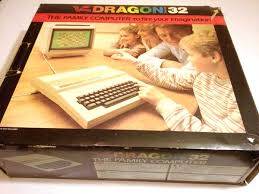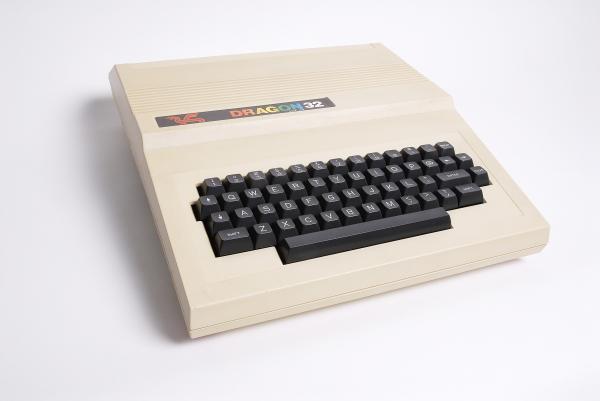 Dragon Data Ltd created its first home computer in August 1982 with the introduction of the Dragon 32. Upon its release there was already a vast range of more superior home computers avaliable on the market, only a year later they followed up with a revised version called the Dragon 64 in an attempt to keep up with its rivals. The models were distinguishable by their numbers with one having 32K of memory and the other having 64K.
Dragon Data Ltd created its first home computer in August 1982 with the introduction of the Dragon 32. Upon its release there was already a vast range of more superior home computers avaliable on the market, only a year later they followed up with a revised version called the Dragon 64 in an attempt to keep up with its rivals. The models were distinguishable by their numbers with one having 32K of memory and the other having 64K.
Dragon Data started life as a relatively small toy company based in Port Talbot, Wales. Due to their gradual success within the toy market and sales growing quite healthily, with the noticable rise in the home computer market and even more so in computer gaming, they decided to branched out and venture into the computer industry creating a system similar to the TRS-80 Color Computer.
Again, their successful began to grow quite rapidly and it wasn’t long before they were manufacturing systems for the European market. Dragon systems that were manufactured and released within the U.S. were produced by a company called Tano who were based New Orleans, Louisiana.
Dragon computers boasted an advanced 8-bit CPU design featuring a Motorola MC6809E processor running at 0.89 MHz and having, among other things, limited 16-bit capabilities compared to the older MOS Technology 6502 of other computer systems.
Here’s a copy of Donkey Kong I managed to find, to me it looks like its off a ZX81 only it has sound
Strangely enough, not all Dragon computers were actually the same due to manufacturing variances. With the use of the command POKE 65495,0, it was possible to increase the speed of the computer. This command accelerated the ROM-resident BASIC interpreter, but the down side with that it temporarily disabled the correct function of the cassette/printer ports. Some systems were able to function at this higher speeds and some even faster with the use of POKE 65497,0.
Most systems were useable with the use of these poke commands but in some it caused the units to crash with some even loosing functions like the screen display, this was only temporary until a slower speed was restored. This really was the limit of pushing these machine and despite this no permanent damage was ever reported to have sustained. With the use of POKE 65494,0, this command returned the system back to its normal speed.
This feature was never exploited purely because of these variances and a much more key factor was the rather poor graphical and musical capabilities that the Dragon provided could not compair to what other games machines provided to consumers at the time.
A selection of five high resolution modes were available to the user, named PMODEs 0-4, which alternate monochrome and four-colour in successively higher resolutions, culminating in the black and white 256×192 PMODE 4. Each mode has two possible colour palettes. Unfortunately, these are rather garish and cause the system to fare poorly in visual comparisons with other home computers of the time. It is also impossible to use standard printing commands to print text on the graphical modes, causing software development difficulties.
A complete Disk Operating System (DOS) was produced by a third-party supplier, Premier Microsystems located near Croydon, South London.
The system was sold as the “Delta” disk operating system. Although Premier offered the Delta system to be marketed by Dragon themselves, Dragon were not happy that a third party were hijacking the standards for their computer, and produced their own rival DragonDOS system making it clear that the third party Delta was not compatible with the ‘standard’ Dragon Disk system.
Some great machine have been created and some not so good, but bold companies that created computers like the Dragon were needed back then and because of them, they have their own place in gaming history.
System Specifications
CPU: Motorola 6809E @ 0.89MHz
Graphics: MC6847 Video Display Generator
Display: Max 256×192 monochrome. Several 4 colour modes available at lower resolution.
Sound: 1 voice, 5 octaves with the Basic. 4 voices, 7 octaves with machine code.
Memory: 32k RAM. 16K ROM – EPROM comprising Microsoft Extended BASIC.
Software Media: Cartridge & Cassette (floppy disk drives were available, if uncommon).
 Only a small library of games, approximately 110 were available for the Dragon computers, so in an attempt to raise sales they went down a similar road as Amstrad with there computer games. A software company called Am-soft wrote a number of games for the Amstrad computers that featuring a hero called Roland who appeared in such games as Roland on the Ropes and Roland in Space. Dragon had a similar hero in the form of Cuthbert created by Microdeal with titles like Cuthbert goes Digging and Cuthbert goes Walkabout etc.
Only a small library of games, approximately 110 were available for the Dragon computers, so in an attempt to raise sales they went down a similar road as Amstrad with there computer games. A software company called Am-soft wrote a number of games for the Amstrad computers that featuring a hero called Roland who appeared in such games as Roland on the Ropes and Roland in Space. Dragon had a similar hero in the form of Cuthbert created by Microdeal with titles like Cuthbert goes Digging and Cuthbert goes Walkabout etc.
The more popular games were ported from more successful computers like Manic Miner, Frogger, Hunchback and Moon Cresta
Here is a list of some of the games that were available for the Dragon Computers
ABC
F |
GHJKMP |
P cont.QSTVW |
